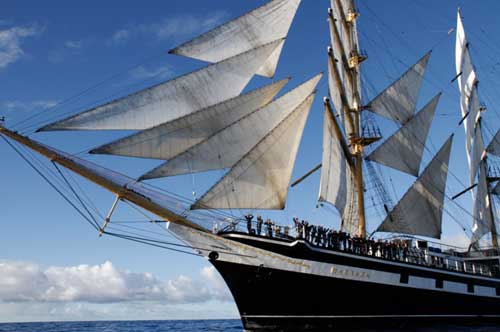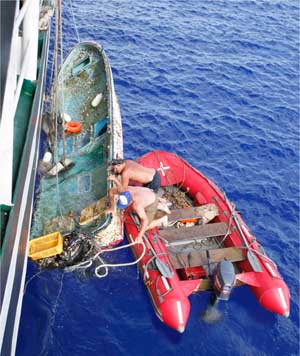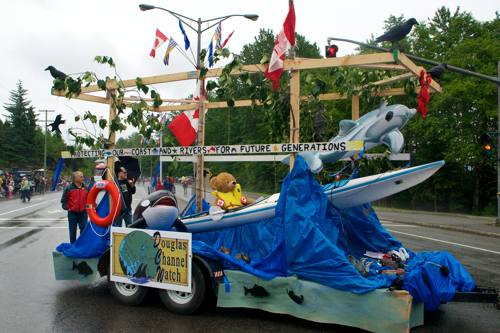Editorial
Originally published July 22, 2011
Twice in as many days this week, the new Conservative Minister of Natural Resources, Joe Oliver, has prejudged the outcome of National Energy Board hearings on both pipeline projects that could be built to the port of Kitimat, the Enbridge Northern Gateway which would carry oil sands bitumen and the KM LNG project which would carry natural gas for liquefaction at a Kitimat terminal.
So we have a minister of the Crown, who will have influence around a cabinet table, once the NEB conclusions are presented to the “Governor in Council,” making it clear that he has already made up his mind on the issues.
The National Energy Board hearings are “quasi-judicial,” that is they have a special legal status and as people who attended the hearings know, special legal procedures, so that the board can fulfill the mandate from Parliament that the board decide whether or not an energy project is in the Canadian “public interest.”
If NEB hearings were full legal proceedings before a court, no cabinet minister would dare to make a public prejudgement. (“It’s before the courts”) But the NEB and oil and gas, of course, are different, the quasi in quasi-judicial opens the door to allow Joe Oliver to say what he thinks, likely before even being fully briefed.
Oliver has already as widely reported, said his government supports the project. “Gateway in our opinion is in the national interest,” he said.
National interest. Public interest. Same thing. A clear message to the (supposedly independent) National Energy Board.
Then today, as widely reported on energy industry tweets (but not so far in the mainstream media) Oliver was interviewed the subscription only Platts LNG Daily and the tweets quote the Platt’s report as saying “Canada’s Natural Resources Minister Joe Oliver said that he expects the National Energy Board to approve the 20-year LNG export license sought by Kitimat LNG this upcoming fall. Minister Oliver noted that this license would be the first for exporting natural gas to a market outside the United States.”
The NEB hearings on KM LNG just wrapped up last week. Again we have the minister prejudging the issue.
Could this be a rookie MP and rookie cabinet minister making rookie mistakes (he hasn’t been briefed fully on how his ministry works?), after all according to his official profile on the Parliament of Canada website, Oliver has just (as of this writing) 81 Days (2 months, 21 days) of federal service?
For a rookie, Oliver has had a very high profile in the past few weeks. (In contrast, we’ve hardly heard a peep out of another star Conservative rookie, former cop Julian Fantino, since he took his seat in the Commons).
Given Prime Minister Stephen Harper’s tight control of the cabinet and what cabinet ministers have said during the minority years, it is clear that Oliver would not be making these statements without the approval of the prime minister himself.
First came Oliver’s July 14 interview with Bloomberg,
Oliver, in a telephone interview with Bloomberg News, said he plans a global campaign to challenge “exaggerated rhetoric” about the environmental impact of Alberta’s oil sands. Canada also must build new markets for its oil, which is now shipped primarily to the U.S., he said.
A few days later, Oliver made it clear he wants to streamline the regulatory process, cut out the red tape, as reported in the Calgary Herald
Oliver said Thursday the country needs better regulation of proposed projects considered to be of national interest, including pipelines and natural gas liquefaction and export facilities for the West Coast.
He said he wants to reduce duplication between jurisdictions through a “one-project, one-review” process of projects to grow energy markets in North America and Asia, including Enbridge’s proposed Northern Gateway pipeline, which would ship bitumen from the oilsands to B.C.’s West Coast, and TransCanada Corp.’s proposed Keystone XL pipeline, which would transport oilsands production to U.S. Gulf Coast refineries.
“You don’t undermine regulatory independence, necessarily, by putting time frames on decisions,” Oliver said. “There’s got to be checks and balances, but I think we can do more to avoid duplication and think about mechanisms to tighten up the time to do fulsome reviews.”
So much for the ordinary people who live along the pipeline routes, most of whom are not familiar and not always able to understand the procedures in hearings that have been the home for years of high-priced energy lawyers from Canada’s major law firms.
Then came the energy minister’s meeting in Alberta, where along with the idea that Enbridge Northern Gateway is in the “national interest” (the spin that Enbridge has been using for the past several months) Oliver agreed with Alberta Energy Minister Ron Lieper’s contention that Canada should become an “energy superpower” with Enbridge as a keystone, as reported in the Edmonton Journal (reprinted in the Vancouver Sun)
Alberta Energy Minister Ron Liepert said Enbridge’s proposed Northern Gateway heavy crude pipeline between the Edmonton area and Kitimat, B.C., called a key export link to Asia, would benefit from a national policy.
Northern Gateway is going through National Energy Board hearings starting in January, Liepert said Tuesday at the conclusion of the two-day national energy summit held in Kananaskis Country.
“I would presume before September of next fall that we can work as governments to ensure that the federal cabinet can expedite that decision because, ultimately, it will be a federal cabinet decision.”
Federal Natural Resources Minister Joe Oliver said the [ministers’ national energy] plan’s collaborative approach “implies agreement to exploit resources in a socially and environmentally responsible way for all Canadians.”
He said that “Asia is a growing market and China, in particular, is the biggest consumer of energy in the world, so we are supportive of the Gateway project because it will open up exports.”
British Columbia did not send a minister to the meeting but officials did sign the final agreement.
Let’s make it clear, the Harper government does have a majority and any government should be free to follow the policies that it believes it was elected to implement. Stephen Harper has pushing the idea of an “energy superpower” for years.
What is not acceptable, however, is for Oliver and the Harper government to treat the LNG hearings that just concluded and the upcoming Northern Gateway hearings as a something the government can ignore because Conservatives already know what the “national interest” is. That is for the NEB panel to discover. Of course, the government is free to disagree, after the hearings and after the final report and recommendations.
Oliver’s prejudgement is not fair to the people of northern and northwestern British Columbia who have genuine concerns about the environmental consequences of the pipelines and the tankers.
Nor is this prejudgement fair to the energy industry (and the stockholders of companies like Enbridge, Apache, Encana and EOG) who have spent millions of dollars for environmental impact studies and millions more in planning to make the projects as safe as their engineers can make it (within the need of those companies to make a profit).
(It should be noted that there seems to be growing support in the northwest for the LNG projects but growing opposition to the Enbridge Northern Gateway)
Enbridge has identified environmental hazards on both the pipeline route and in the waters of British Columbia and come up with what the company believes are solutions. Those hazards and the proposed solutions were explained publicly at town meetings in Kitimat and documents are available on the Joint Review website.
Those who oppose the Northern Gateway project say those hazard studies and proposed solutions are inadequate.
It is doubtful that Oliver has even had a summary briefing of the problems that Enbridge has identified. Would Enbridge be willing to spend millions of dollars on tunnels and bridges across the mountains of British Columbia and install navigation aides along Douglas Channel and the Inside Passage if the environmental concerns were just “exaggerated rhetoric?’
A lot of people in the northwest region already believe that the Joint Review hearings are a sham, that the Enbridge pipeline will be approved by the cabinet no matter what testimony the board hears both in the community hearings in January and the formal hearings later in 2012 and no matter what recommendations the board panel may make to cabinet. Oliver’s statements this week tend to confirm this belief.
One has to wonder, whether supporters or opponents of the Northern Gateway pipeline, if all the money being budgeted for these hearings is being well spent in this time of restraint if the outcome is preordained: the millions of dollars allocated by the government for the hearings, millions more from Enbridge’s treasury, hundreds of thousands of dollars spent by intervenors and hundreds or even thousands of dollars scrimped and saved by those who make oral statements. Then there are the thousands of hours of research and study by Enbridge, thousands of hours of research and legal work by the National Energy Board and the Environmental Assessment agency staff, tens of thousands of billable hours by all the lawyers, hours of work by individuals, whether they oppose or support the project, who give up their time to craft an intervention or an oral statement.
It is entirely likely the Joint Review Panel will make every effort to come a to a fair and equitable decision.
The Joint Review Panel has to decide in the interests of all Canadians, which means the interests of northern British Columbia are only part of the decision. The current campaign by Enbridge that the pipeline is a new national challenge to join the country together like the nineteenth century railways, looks like it is aimed at the “all Canadians” mandate of the NEB panel.
Here is where Oliver’s prejudgment of the issues before NEB panels, especially when he said the Enbridge project is in “the national interest” is another blow to Canadian democratic tradition. This shouldn’t be ideological. Once, not so long ago, Conservatism meant respecting traditions, especially the hundreds of years of parliamentary and legal traditions we inherited from Great Britain. Canada then developed a Canadian version of that tradition. As Canadians have seen, Stephen Harper and the cabinet members around him have no respect for those traditions. The NEB hearings, decisions by other independent bodies, appear to be an inconvenience, just as a sitting parliament was an inconvenience at the time of the two prorogations of parliament.
That Joint Review decision, if it is against the pipeline, is not binding on the Harper government, which clearly over the past years has shown a pro-Alberta, pro-oil sands and anti-environment bias. The governor in council, the cabinet, as is well known, is dominated by Stephen Harper, who does not tolerate dissent.
Given the NEB mandate, there is a good chance that the pipeline will be approved, but likely with contingents and limitations that take into consideration the concerns of northern British Columbia.
In the final analysis, after all this, after millions of dollars, lifetimes of work, hours of hearings and deliberation, the decision on the Northern Gateway pipeline and those inconvenient considerations will be made by just one man, Stephen Harper, who is unlikely to attend a single hearing, read a transcript or study the millions of pages of evidence. Joe Oliver’s media blitz in the past two weeks has already shown how the prime minister and cabinet think, the Enbridge pipeline must go ahead despite all the potential dangers. The outcome has already been prejudged. (As noted earlier there is much less opposition to the LNG projects across the northwest, but once again it is clear that the Harper government is prejudging the outcome and the NEB decision on the LNG terminal).
Before supporters cheer and the opponents lament, that very arbitrary nature of a cabinet decision by the current government, dominated by the current Prime Minister, the fact the NEB hearings could likely be seen as a worthless sham, will also likely mean court and possibly other challenges, challenges that could last for years.
Sham NEB hearings, prejudged by the Joe Oliver, Stephen Harper and the rest of the cabinet, will be just as disastrous for the energy companies as it will be for the environmental movement, especially in today’s polarized world where compromise is often impossible.
The energy companies probably do really believe these pipelines are a
new national dream, not a national nightmare and their environmental
safeguards will meet the test. But if the Joint Review hearings are seen as worthless, then statements and policies by the energy companies will also be seen as worthless far beyond the “activists” in the environmental movement.
The pipeline must cross the traditional territory of many First Nations, most of whom have not agreed to Enbridge’s terms and some who say they oppose the Enbridge pipeline. The role of First Nations could also mean, at the very least, many court challenges.
The first accident during the construction process, and there will be accidents, or a tanker accident on the coast, and there will be tanker accidents on the coast, even if unrelated to Enbridge, will mean headlines, demonstrations, questions in the Commons, more time in court.
It would have been better if Joe Oliver, Stephen Harper and their colleagues had kept an open mind on the issue until all the facts, opinions and options had been independently examined by the Joint Review Panel. But as on other contentious issues, unfortunately, the Conservatives appear to have already decided the outcome.
So if events unfold as it appears they will unfold, a decade or more from now, a final decision on the Northern Gateway pipeline may end up in the hands of Canada’s judiciary, an arm that is, for the moment, independent of the government, with a decision coming perhaps after Stephen Harper has retired as Prime Minister, and Joe Oliver has returned to Bay Street.
Then once the case is concluded, all the work done for the Joint Review Panel hearings, will be shipped to Library and Archives Canada in Gatineau, to gather dust until, in another decade or two, someone can write their Phd dissertation on what went wrong.
 The Russian sail training vessel STS Pallada. (Pallada)
The Russian sail training vessel STS Pallada. (Pallada) A map of the tsunami debris field by Nikolai Maximenko and Jan Hafner of IPRC. The line shows the track of the Pallada where the debris was spotted between Sept. 21 and Sept. 28, 2011. The red rhombus (diamond) marks the location where the Japanese boat was found. The red circle denotes maximum debris density spotted by the Pallada. The purple shows the extent of the debris field from the updated university computer model as of Sept. 25. Click for larger image. (IPRC)
A map of the tsunami debris field by Nikolai Maximenko and Jan Hafner of IPRC. The line shows the track of the Pallada where the debris was spotted between Sept. 21 and Sept. 28, 2011. The red rhombus (diamond) marks the location where the Japanese boat was found. The red circle denotes maximum debris density spotted by the Pallada. The purple shows the extent of the debris field from the updated university computer model as of Sept. 25. Click for larger image. (IPRC) The crew of the Pallada hoists on board a Japanese boat, registered in Fukishima prefecture, and presumably washed out to sea during the March 11, 2011 tsunami. (Pallada)
The crew of the Pallada hoists on board a Japanese boat, registered in Fukishima prefecture, and presumably washed out to sea during the March 11, 2011 tsunami. (Pallada)




 The last time National Geographic visited Kitimat was in 1956, with a major article when Kitimat was considered a town of the future, 55 years ago. Perhaps, in the interests of journalistic accuracy and credibility, National Geographic should come back before 2066.
The last time National Geographic visited Kitimat was in 1956, with a major article when Kitimat was considered a town of the future, 55 years ago. Perhaps, in the interests of journalistic accuracy and credibility, National Geographic should come back before 2066.
